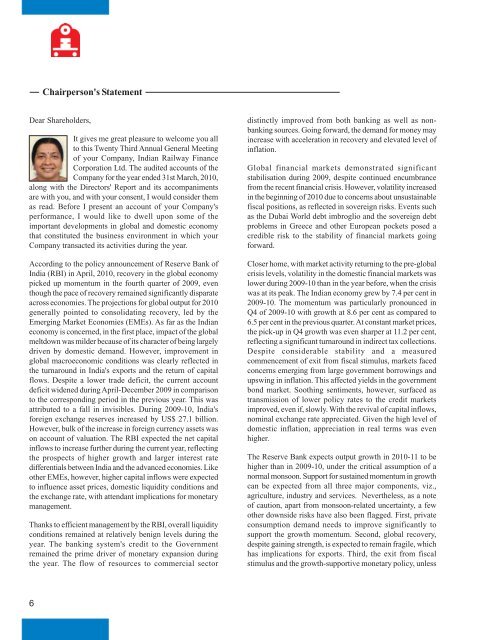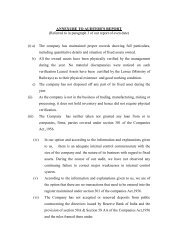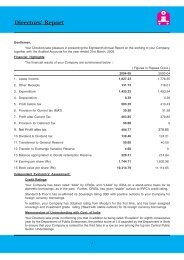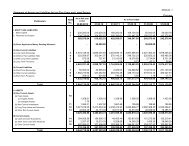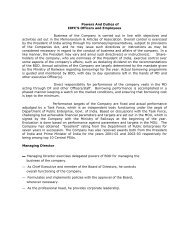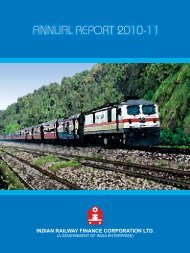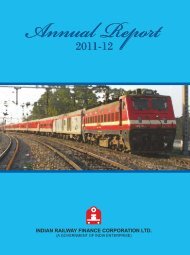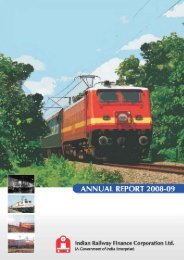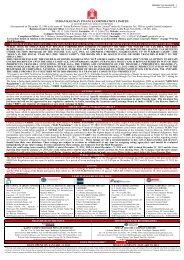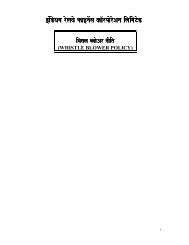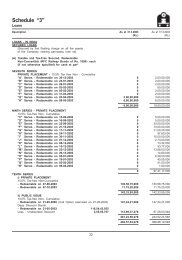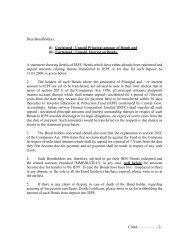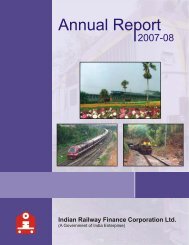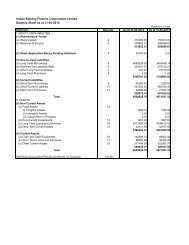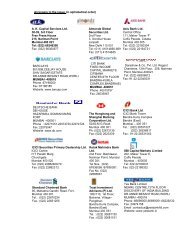IRFC COVER-final - Indian Railway Finance Corporation Ltd.
IRFC COVER-final - Indian Railway Finance Corporation Ltd.
IRFC COVER-final - Indian Railway Finance Corporation Ltd.
- No tags were found...
You also want an ePaper? Increase the reach of your titles
YUMPU automatically turns print PDFs into web optimized ePapers that Google loves.
Chairperson's StatementDear Shareholders,It gives me great pleasure to welcome you allto this Twenty Third Annual General Meetingof your Company, <strong>Indian</strong> <strong>Railway</strong> <strong>Finance</strong><strong>Corporation</strong> <strong>Ltd</strong>. The audited accounts of theCompany for the year ended 31st March, 2010,along with the Directors' Report and its accompanimentsare with you, and with your consent, I would consider themas read. Before I present an account of your Company'sperformance, I would like to dwell upon some of theimportant developments in global and domestic economythat constituted the business environment in which yourCompany transacted its activities during the year.According to the policy announcement of Reserve Bank ofIndia (RBI) in April, 2010, recovery in the global economypicked up momentum in the fourth quarter of 2009, eventhough the pace of recovery remained significantly disparateacross economies. The projections for global output for 2010generally pointed to consolidating recovery, led by theEmerging Market Economies (EMEs). As far as the <strong>Indian</strong>economy is concerned, in the first place, impact of the globalmeltdown was milder because of its character of being largelydriven by domestic demand. However, improvement inglobal macroeconomic conditions was clearly reflected inthe turnaround in India's exports and the return of capitalflows. Despite a lower trade deficit, the current accountdeficit widened during April-December 2009 in comparisonto the corresponding period in the previous year. This wasattributed to a fall in invisibles. During 2009-10, India'sforeign exchange reserves increased by US$ 27.1 billion.However, bulk of the increase in foreign currency assets wason account of valuation. The RBI expected the net capitalinflows to increase further during the current year, reflectingthe prospects of higher growth and larger interest ratedifferentials between India and the advanced economies. Likeother EMEs, however, higher capital inflows were expectedto influence asset prices, domestic liquidity conditions andthe exchange rate, with attendant implications for monetarymanagement.Thanks to efficient management by the RBI, overall liquidityconditions remained at relatively benign levels during theyear. The banking system's credit to the Governmentremained the prime driver of monetary expansion duringthe year. The flow of resources to commercial sectordistinctly improved from both banking as well as nonbankingsources. Going forward, the demand for money mayincrease with acceleration in recovery and elevated level ofinflation.Global financial markets demonstrated significantstabilisation during 2009, despite continued encumbrancefrom the recent financial crisis. However, volatility increasedin the beginning of 2010 due to concerns about unsustainablefiscal positions, as reflected in sovereign risks. Events suchas the Dubai World debt imbroglio and the sovereign debtproblems in Greece and other European pockets posed acredible risk to the stability of financial markets goingforward.Closer home, with market activity returning to the pre-globalcrisis levels, volatility in the domestic financial markets waslower during 2009-10 than in the year before, when the crisiswas at its peak. The <strong>Indian</strong> economy grew by 7.4 per cent in2009-10. The momentum was particularly pronounced inQ4 of 2009-10 with growth at 8.6 per cent as compared to6.5 per cent in the previous quarter. At constant market prices,the pick-up in Q4 growth was even sharper at 11.2 per cent,reflecting a significant turnaround in indirect tax collections.Despite considerable stability and a measuredcommencement of exit from fiscal stimulus, markets facedconcerns emerging from large government borrowings andupswing in inflation. This affected yields in the governmentbond market. Soothing sentiments, however, surfaced astransmission of lower policy rates to the credit marketsimproved, even if, slowly. With the revival of capital inflows,nominal exchange rate appreciated. Given the high level ofdomestic inflation, appreciation in real terms was evenhigher.The Reserve Bank expects output growth in 2010-11 to behigher than in 2009-10, under the critical assumption of anormal monsoon. Support for sustained momentum in growthcan be expected from all three major components, viz.,agriculture, industry and services. Nevertheless, as a noteof caution, apart from monsoon-related uncertainty, a fewother downside risks have also been flagged. First, privateconsumption demand needs to improve significantly tosupport the growth momentum. Second, global recovery,despite gaining strength, is expected to remain fragile, whichhas implications for exports. Third, the exit from fiscalstimulus and the growth-supportive monetary policy, unless6


